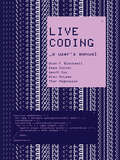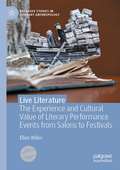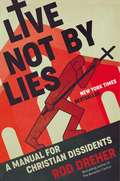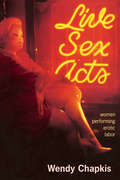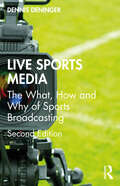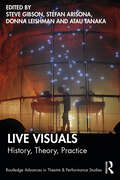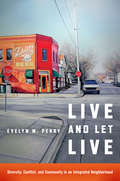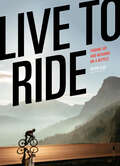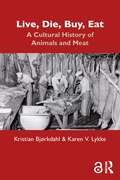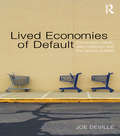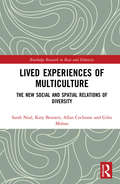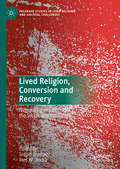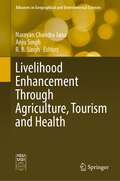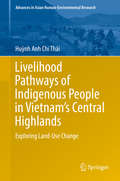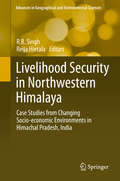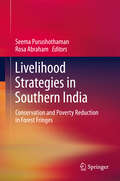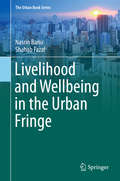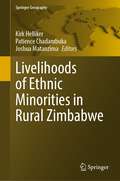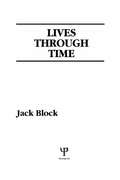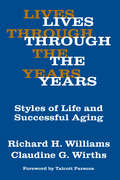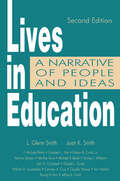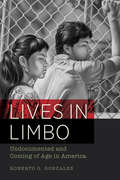- Table View
- List View
Live Coding: A User's Manual (Software Studies)
by Geoff Cox Thor Magnusson Alan F. Blackwell Alex McLean Emma CockerThe first comprehensive introduction to the origins, aspirations, and evolution of live coding.Performative, improvised, on the fly: live coding is about how people interact with the world and each other via code. In the last few decades, live coding has emerged as a dynamic creative practice gaining attention across cultural and technical fields—from music and the visual arts through to computer science. Live Coding: A User&’s Manual is the first comprehensive introduction to the practice, and a broader cultural commentary on the potential for live coding to open up deeper questions about contemporary cultural production and computational culture. This multi-authored book—by artists and musicians, software designers, and researchers—provides a practice-focused account of the origins, aspirations, and evolution of live coding, including expositions from a wide range of live coding practitioners. In a more conceptual register, the authors consider liveness, temporality, and knowledge in relation to live coding, alongside speculating on the practice&’s future forms.
Live Literature: The Experience and Cultural Value of Literary Performance Events from Salons to Festivals (Palgrave Studies in Literary Anthropology)
by Ellen WilesThis ground-breaking book explores the phenomenal growth of live literature in the digitalizing 21st century. Wiles asks why literary events appeal and matter to people, and how they can transform the ways in which fiction is received and valued. Readers are immersed in the experience of two contrasting events: a major literary festival and an intimate LGBTQ+ salon. Evocative scenes and observations are interwoven with sharp critical analysis and entertaining conversations with well-known author-performers, reader-audiences, producers, critics, and booksellers. Wiles’s experiential literary ethnography represents an innovative and vital contribution, not just to literary research, but to research into the value of cultural experience across art forms. This book probes intersections between readers and audiences, writers and performers, texts and events, bodies and memories, and curation and reception. It addresses key literary debates from cultural appropriation to diversity in publishing, the effects of social media, and the quest for authenticity. It will engage a broad audience, from academics and producers to writers and audiences.
Live Longer with AI: How artificial intelligence is helping us extend our healthspan and live better too
by Andrew Scott Tina Woods Melissa ReamA fascinating journey from before birth to death on how technology can be harnessed to help us live healthier, longer, and better lives Key Features 20 of the world's top experts on artificial intelligence, genomics and longevity share their insights on bringing health and wealth together to live longer and better A scientifically-backed exploration on how technology can help us understand the current pandemic, equip ourselves better for the next one, and live our best lives in a post-Covid-19 world Discover how AI is accelerating our understanding of aging at a cellular level and can help us keep healthy across our life course – moving away from sick care to well-being Book Description Live Longer with AI examines how the latest cutting-edge developments are helping us to live longer, healthier and better too. It compels us to stop thinking that health is about treating disease and start regarding it as our greatest personal and societal asset to protect. The book discusses the impact that AI has on understanding the cellular basis of aging and how our genes are influenced by our environment – with the pandemic highlighting the interconnectedness of human and planetary health. Author Tina Woods, founder and CEO of Collider Health and Collider Science, and the co-founder of Longevity International, has curated a panel of deeply insightful interviews with some of today's brightest and most innovative thought leaders at the crossroads of health, technology and society, including: Professor Nir Barzilai, Albert Einstein College of Medicine, an expert in the genetics of longevity, and leading the first trial ever of an anti-aging treatment to help us live longer better Alex Zhavoronkov, Founder and CEO at Insilico Medicine, trailblazer in aging biomarker research and AI-driven discovery, and now leading the search for Covid-19 treatments to make us more resilient to future pandemic threats Eddie Hall, the world's strongest man carrying the “Hercules” gene, who relies on epigenetics to guide him to a healthier life About the consultant editor Melissa Ream is a leading health and care strategist in the UK, leveraging user-driven design and artificial intelligence to design systems and support people to live healthier, longer lives. What you will learn Discover how AI is changing the way we understand the wider determinants of health, how the environment influences our genes and why the solutions for living longer are linked to living greener Inform your perspective on how technology can deal with the health emergency in front of us – by minimizing health and wealth inequalities Personalize your health, wealth and well-being using technology best suited to help you plan and build up your assets for a multi-stage life Learn why our “life data” is so important and how sharing it will help us develop aging “bio-markers”, enabling us to predict and manage dementia and other chronic diseases of aging Find out how scientists and doctors are using AI to find a vaccine for Covid-19, make us more resilient to future pandemic threats and pre-empt the next outbreak Who this book is for Professionals and general readers with an interest in learning how technology can and is being used to change our approach to aging and help us live longer and healthier lives. No prior knowledge of or experience with artificial intelligence is required.
Live Not By Lies: A Manual For Christian Dissidents
by Rod DreherThe New York Times bestselling author of The Benedict Option draws on the wisdom of Christian survivors of Soviet persecution to warn American Christians of approaching dangers. For years, émigrés from the former Soviet bloc have been telling Rod Dreher they see telltale signs of "soft" totalitarianism cropping up in America--something more Brave New World than Nineteen Eighty-Four. Identity politics are beginning to encroach on every aspect of life. Civil liberties are increasingly seen as a threat to "safety". Progressives marginalize conservative, traditional Christians, and other dissenters. Technology and consumerism hasten the possibility of a corporate surveillance state. And the pandemic, having put millions out of work, leaves our country especially vulnerable to demagogic manipulation. In Live Not By Lies, Dreher amplifies the alarm sounded by the brave men and women who fought totalitarianism. He explains how the totalitarianism facing us today is based less on overt violence and more on psychological manipulation. He tells the stories of modern-day dissidents--clergy, laity, martyrs, and confessors from the Soviet Union and the captive nations of Europe--who offer practical advice for how to identify and resist totalitarianism in our time. Following the model offered by a prophetic World War II-era pastor who prepared believers in his Eastern European to endure the coming of communism, Live Not By Lies teaches American Christians a method for resistance: * SEE: Acknowledge the reality of the situation. * JUDGE: Assess reality in the light of what we as Christians know to be true. * ACT: Take action to protect truth. Aleksandr Solzhenitsyn famously said that one of the biggest mistakes people make is assuming totalitarianism can't happen in their country. Many American Christians are making that mistake today, sleepwalking through the erosion of our freedoms. Live Not By Lies will wake them and equip them for the long resistance.
Live Sex Acts: Women Performing Erotic Labor (Sexual Politics Ser.)
by Wendy ChapkisDrawing on more than fifty interviews in both the US and the Netherlands, Wendy Chapkis captures the wide-ranging experiences of women performing erotic labor and offers a complex, multi-faceted depiction of sex work. Her expansive analytic perspective encompasses both a serious examination of international prostitution policy as well as hands-on accounts of contemporary commercial sexual practices. Scholarly, but never simply academic, this book is explicitly grounded in a concern for how competing political discourses work concretely in the world--to frame policy and define perceptions of AIDS, to mobilize women into opposing camps, to silence some agendas and to promote others.
Live Sports Media: The What, How and Why of Sports Broadcasting
by Dennis DeningerIn Live Sports Media: The What, How and Why of Sports Broadcasting, Dennis Deninger provides an all-encompassing view of the sports television industry from his own perspective as an Emmy Award-winning producer at ESPN, at a time of seismic shifts in the industry. Technological advances and the proliferation of sports content across multiple media platforms have increased accessibility to sports events of all kinds across the world. Shifts in viewing habits and audience preferences are changing the dynamic of sports media and the sports industry as a whole. The result: more power for some sectors and diminished power for many others, to which professionals in the field need to rapidly adapt. This second edition has been substantially updated to explore the impact of COVID-19 disruptions on sports and the growth of women's sports broadcasting and evolving sports, as well as political statements made in sports: Black Lives Matter, and "taking a knee." It illustrates the origins, impact, reach, economics, production, and presentation of sports on video media – including, but not limited to, television. It takes the reader behind the scenes to describe the forces and processes that have shaped and continue to change sports content, its delivery, and how it connects with fans. Dennis Deninger draws from his experiences as an expert in the industry to expose how the choices and decisions that are now being made affect the programming, content, storytelling, production, advertising, and delivery of the sports broadcasting that we will see next season and how it will evolve in the years to come. This practical, entertaining book provides insights into sports broadcasting that sports management, media, and journalism students and learning practitioners will not find anywhere else.
Live Visuals: History, Theory, Practice (Routledge Advances in Theatre & Performance Studies)
by Steve Gibson Stefan Arisona Donna Leishman Atau TanakaThis volume surveys the key histories, theories and practice of artists, musicians, filmmakers, designers, architects and technologists that have worked and continue to work with visual material in real time. Covering a wide historical period from Pythagoras’s mathematics of music and colour in ancient Greece, to Castel’s ocular harpsichord in the 18th century, to the visual music of the mid-20th century, to the liquid light shows of the 1960s and finally to the virtual reality and projection mapping of the present moment, Live Visuals is both an overarching history of real-time visuals and audio-visual art and a crucial source for understanding the various theories about audio-visual synchronization. With the inclusion of an overview of various forms of contemporary practice in Live Visuals culture – from VJing to immersive environments, architecture to design – Live Visuals also presents the key ideas of practitioners who work with the visual in a live context. This book will appeal to a wide range of scholars, students, artists, designers and enthusiasts. It will particularly interest VJs, DJs, electronic musicians, filmmakers, interaction designers and technologists.
Live and Die Like a Man: Gender Dynamics in Urban Egypt
by Farha GhannamWatching the revolution of January 2011, the world saw Egyptians, men and women, come together to fight for freedom and social justice. These events gave renewed urgency to the fraught topic of gender in the Middle East. The role of women in public life, the meaning of manhood, and the future of gender inequalities are hotly debated by religious figures, government officials, activists, scholars, and ordinary citizens throughout Egypt. Live and Die Like a Man presents a unique twist on traditional understandings of gender and gender roles, shifting the attention to men and exploring how they are collectively "produced" as gendered subjects. It traces how masculinity is continuously maintained and reaffirmed by both men and women under changing socio-economic and political conditions. Over a period of nearly twenty years, Farha Ghannam lived and conducted research in al-Zawiya, a low-income neighborhood not far from Tahrir Square in northern Cairo. Detailing her daily encounters and ongoing interviews, she develops life stories that reveal the everyday practices and struggles of the neighborhood over the years. We meet Hiba and her husband as they celebrate the birth of their first son and begin to teach him how to become a man; Samer, a forty-year-old man trying to find a suitable wife; Abu Hosni, who struggled with different illnesses; and other local men and women who share their reactions to the uprising and the changing situation in Egypt. Against this backdrop of individual experiences, Ghannam develops the concept of masculine trajectories to account for the various paths men can take to embody social norms. In showing how men work to realize a "male ideal," she counters the prevalent dehumanizing stereotypes of Middle Eastern men all too frequently reproduced in media reports, and opens new spaces for rethinking patriarchal structures and their constraining effects on both men and women.
Live and Let Live: Diversity, Conflict, and Community in an Integrated Neighborhood
by Evelyn M. PerryWe are in a bind," writes Evelyn M. Perry. While conventional wisdom asserts that residential racial and economic integration holds great promise for reducing inequality in the United States, Americans are demonstrably not very good at living with difference. Perry's analysis of the multiethnic, mixed-income Milwaukee community of Riverwest, where residents maintain relative stability without insisting on conformity, advances our understanding of why and how neighborhoods matter. In response to the myriad urban quantitative assessments, Perry examines the impacts of neighborhood diversity using more than three years of ethnographic fieldwork and interviews. Her in-depth examination of life "on the block" expands our understanding of the mechanisms by which neighborhoods shape the perceptions, behaviors, and opportunities of those who live in them. Perry challenges researchers' assumptions about what "good" communities look like and what well-regulated communities want. Live and Let Live shifts the conventional scholarly focus from "What can integration do?" to "How is integration done?"
Live to Ride: Finding Joy and Meaning on a Bicycle
by Peter FlaxA visual celebration of the beauty and lure of bicycle culture by renowned cycling journalist Peter FlaxLive to Ride is an ode to cycling from one of the world&’s most respected cycling journalists. The bicycle is one of the greatest inventions in human history. It can literally transport you to places you want to go—to your school or office, to the summit of a local hilltop, to some objective in your pursuit of fitness—but it can do more than that. A bicycle can also transport you to an entirely different mindset, a place where you can embrace the unexpected and live in the moment. People are drawn to riding for many of the same reasons—to test themselves, find themselves, and express themselves. To find some peace and beauty. To inject fun and adventure into their busy lives.Live to Ride is an illustrated gift book for those who love to bike. It&’s for every type of cyclist—from mountain bikers, to commuters, to tourers and triathletes and beach cruisers and bikepackers and messengers. To wheelie kids, to vintage bike collectors. Author, Peter Flax, a celebrated cycling journalist, is here to show us that cycling should be inclusive—that all riders are connected in various, yet similar, ways. Organized by theme, each one exploring what Flax believes are the shared reasons that people ride: Adventure, Speed, Utility, Nature, Competition, and Self-Expression. Within each chapter are interviews and profiles with a diverse list of famed riders, both legendary and contemporary. Also included is the ultimate destination ride, with a map, based on that chapter&’s theme; and insider info like the one perfect bike; and essential gear that a rider needs to be in the know about. Modern and sleek in its design, and filled with a mix of photography and illustration, this is both a book any rider will cherish for years to come.
Live, Die, Buy, Eat: A Cultural History of Animals and Meat
by Kristian Bjørkdahl Karen V. LykkeLive, Die, Buy, Eat. These words represent a chain of events which today is disconnected. In the past few years, controversies around meat have arisen around industrialization and globalization of meat production, often pivoting around health, environmental issues, and animal welfare. Although meat increasingly figures as a problem, most consumers’ knowledge of animal husbandry and meat production is more absent than ever. Tracing a historical process of alienation along three distinct axes, the authors show how the animal origin of meat is covered up, rationalized, forgotten, excused, neglected, and denied. How is meat produced today, and where? How do we consume meat, and how have our consumption habits changed? Why have these changes occurred, and what are the social and cultural consequences of these changes? Using Norway as a case study, this book examines the dramatic changes in meat production and consumption over the last 150 years. With a wide range of historical sources, together with interviews and observation at farms, slaughterhouses, and production units, as well as analyses of contemporary texts and digital sources, Live, Die, Buy, Eat explores the transformation of animal husbandry, meat production and consumption, together with its cultural consequences. It will appeal to scholars of anthropology, sociology, cultural studies, geography, and history with an interest in food, agriculture, environment, and culture.
Lived Economies of Default: Consumer Credit, Debt Collection and the Capture of Affect (CRESC)
by Joe DevilleConsumer credit borrowing – using credit cards, store cards and personal loans – is an important and routine part of many of our lives. But what happens when these everyday forms of borrowing go ‘bad’, when people start to default on their loans and when they cannot, or will not, repay? It is this poorly understood, controversial, but central part of both the consumer credit industry and the lived experiences of an increasing number of people that this book explores. Drawing on research from the interior of the debt collections industry, as well as debtors' own accounts and historical research into technologies of lending and collection, it examines precisely how this ever more sophisticated, globally connected market functions. It focuses on the highly intimate techniques used to try and recoup defaulting debts from borrowers, as well as on the collection industry’s relationship with lenders. Joe Deville follows a journey of default, from debtors’ borrowing practices, to the intrusion of collections technologies into their homes and everyday lives, to the collections organisation, to attempts by debtors to seek outside help. In the process he shows how to understand this particular market, we need to understand the central role played within it by emotion and affect. By opening up for scrutiny an area of the economy which is often hidden from view, this book makes a major contribution both to understanding the relationship between emotion and calculation in markets and the role of consumer credit in our societies and economies. This book will be of interest to students, teachers and researchers in a range of fields, including sociology, anthropology, cultural studies, economics and social psychology.
Lived Experiences of Multiculture: The New Social and Spatial Relations of Diversity (Routledge Research in Race and Ethnicity)
by Giles Mohan Allan Cochrane Sarah Neal Katy BennettIn an increasingly ethnically diverse society, debates about migration, community, cultural difference and social interaction have never been more pressing. Drawing on the findings from a two-year, qualitative Economic and Social Research Council funded study of different locations across England, Lived Experiences of Multiculture uses interdisciplinary perspectives to examine the ways in which complex urban populations experience, negotiate, accommodate and resist cultural difference as they share a range of everyday social resources and public spaces. The authors present novel ways of re-thinking and developing concepts such as multiculture, community and conviviality, whilst also repositioning debates which focus on conflict models for understanding cultural differences. Amidst highly charged arguments over the social relations of belonging and the meanings of local and national identities, this timely volume will appeal to advanced undergraduate students and graduate students interested in fields such as Race and Ethnicity Studies, Sociology, Urban Studies, Human Geography and Migration Studies.
Lived Religion, Conversion and Recovery: Negotiating of Self, the Social, and the Sacred (Palgrave Studies in Lived Religion and Societal Challenges)
by Srdjan Sremac Ines W. JindraThe central theme of this book is the nexus between the self, the social, and the sacred in conversion and recovery. The contributions explore the complex interactions that occur between the person, the sacred, and various recovery situations, which can include prisons, substance abuse recovery settings and domestic violence shelters.With an interdisciplinary approach to the study of conversion, the collection provides an opportunity for a better understanding of lived religion, guilt, shame, hope, forgiveness, narrative identity reconstruction, religious coping, religious conversion and spiritual transformation. This volume will be of interest to scholars and students of lived religion, religious conversion, recovery, homelessness, and substance dependence.
Livelihood Enhancement Through Agriculture, Tourism and Health (Advances in Geographical and Environmental Sciences)
by R. B. Singh Narayan Chandra Jana Anju SinghAgriculture is the backbone of our economic system. It provides not only food and raw material but also employment opportunities to a very large number of people. Higher atmospheric temperature has an impact on crop yields while the changes in rainfall could affect both crop quality and quantity. Climate change, therefore, could increase the prices of major crops in some regions. For the most vulnerable people, lower agricultural output means lower income. In addition, climate change is expected to increase the risk of illness and death from extreme heat and poor air quality. Recent evidence is the COVID-19 pandemic. Furthermore, climate change also affects the occurrence of other infectious diseases. A number of well-known diseases are climate-sensitive - malaria, dengue fever, and cholera among others. Tourism is considered as an industry and alternative contributor to a nation’s income. It can generate employment opportunities and boost up the economy. This book, consisting of 26 chapters, focuses on the issues of agriculture, tourism and health for livelihood enhancement. It is essential to discuss these diverse issues in the field of geography as it encompasses interdisciplinary topics. The range of concerns at the national, regional and local levels is not confined to geography only but also involves other disciplines as well. Therefore, this book is a valuable source for scientists and researchers in allied fields such as livelihood, agriculture, land use, tourism management, health care and tribal studies. Furthermore, this book can be of immense help to the researchers, planners and decision makers engaged in solving problems in these areas in developing countries and beyond.
Livelihood Pathways of Indigenous People in Vietnam’s Central Highlands: Exploring Land-Use Change (Advances in Asian Human-Environmental Research)
by Huỳnh Anh Chi TháiThis study focuses on impacts of the environmental and socio-economic transformation on the indigenous people's livelihoods in Vietnam's Central Highlands recent decades since the country's reunification in 1975.The first empirical section sheds light on multiple external conditions (policy reforms, population trends, and market forces) exposed onto local people. The role of human and social capital is examined again in a specific livelihood of community-based tourism to testify the resilience level of local people when coping with constraints. The study concludes with an outlook on implications of development processed which still places agriculture at the primary position livelihood, and pays attention to human capital and social capital of indigenous groups in these highlands.
Livelihood Security in Northwestern Himalaya
by R. B. Singh Reija HietalaThis book identifies and analyzes livelihood impacts of recent environmental and socio-economic changes in urban and rural settings of the mountainous state of Himachal Pradesh, north western Himalaya, India. The findings of the research deal with the broader objectives of the changing patterns of agricultural production with special reference to diversification, as well as forest-based livelihood outcomes, Clean Development Mechanism forest project activities, the roles of different ethnic groups and non-governmental organizations and the benefits and shortcomings of tourism as a livelihood source. These tasks are studied by using an exploratory approach, with participant observation, interviews through random and cluster sampling among villagers, local land users and officials, as well as with land cover interpretation and secondary statistical data. This book is relevant for educational use together with policy input on the issues exploring livelihood security in a rapidly growing developing country.
Livelihood Strategies in Southern India
by Seema Purushothaman Rosa AbrahamThis volume is a compilation of essays that focus on livelihood issues faced by forest communities of the southern Western Ghats region of India. Communities living along the fringes of forests are, more often than not, overlooked in academic and policy discussions. However, they face considerable pressures, being sandwiched between conservation endeavours and the forces of urbanization and commercialization. The chapters in this book provide an insight into the kinds of livelihood issues these communities face and the potential means that can be adopted to sustain these livelihoods. This volume provides a unique alternative perspective by locating livelihood issues within socio-ecological-economic narratives of communities living at the intersection of the three southern Indian states of Karnataka, Kerala and Tamil Nadu, and suggests directions for policies to address these challenges.
Livelihood and Wellbeing in the Urban Fringe
by Shahab Fazal Nasrin BanuThis book presents a detailed study on Aligarh's urban fringe, focusing on the livelihood of the villagers who have lived there for generations, and on that of the migrants residing in the villages. As a Class-I city, located in the most populated state (Uttar Pradesh) of India, Aligarh has gained in importance due to its proximity to the national capital (New Delhi) and Uttar Pradesh's industrial cities (Kanpur and Ghaziabad). The 2011 census showed that of the total population of the district, 33. 1 per cent was urban (872,575 residents). Projections by the Town and Country Planning Department suggest that the city will have some 1. 2 million inhabitants and there will be a need for another 64,000 houses. Thus, the city will expand extensively into its urban fringe, which is expected to entail large-scale transformations. The expansion of the city will significantly influence nearby villages in terms of land use and population, both physically and socio-economically.
Livelihoods of Ethnic Minorities in Rural Zimbabwe (Springer Geography)
by Kirk Helliker Patience Chadambuka Joshua MatanzimaThe book provides empirically-rich case studies of the lives and livelihoods of marginalised ethnic minorities in colonial and post-colonial Zimbabwe, with a specific focus on diverse rural areas. It demonstrates the dynamic and complex relationships existing between ethnic minorities and livelihoods, and analyses the ways in which projects of belonging (and identity-formation) amongst these ethnic minorities are entangled in their respective livelihood construction projects, and vice versa. The ethnic minorities include those considered indigenous to Zimbabwe, and those often defined as ‘aliens’, including ethnicities with a transnational presence in southern Africa. The ethnicities studied in the book include the following: Chewa, Doma, Tonga, Tshwa San, Shangane, Basotho, Ndau, Hlengwe and Nambya. By studying their livelihoods in particular, this book offers the first full manuscript about ethnic minorities in Zimbabwe. In doing so, it highlights the significance of these ethnic minorities to Zimbabwean history, politics and society.
Lively Cities: Reconfiguring Urban Ecology
by Maan BaruaA journey through unexplored spaces that foreground new ways of inhabiting the urban One of the fundamental dimensions of urbanization is its radical transformation of nature. Today domestic animals make up more than twice the biomass of people on the planet, and cities are replete with nonhuman life. Yet current accounts of the urban remain resolutely anthropocentric. Lively Cities departs from conventions of urban studies to argue that cities are lived achievements forged by a multitude of entities, drawing attention to a suite of beings—human and nonhuman—that make up the material politics of city making.From macaques and cattle in Delhi to the invasive parakeet colonies in London, Maan Barua examines the rhythms, paths, and agency of nonhumans across the city. He reconceptualizes several key themes in urban thought, including infrastructure, the built environment, design, habitation, and everyday practices of dwelling and provides a critical intervention in animal and urban studies. Generating fresh conversations between posthumanism, postcolonialism, and political economy, Barua reveals how human and nonhuman actors shape, integrate, subsume, and relate to urban space in fascinating ways.Through novel combinations of ethnography and ethology, and focusing on interlocutors that are not the usual suspects animating urban theory, Barua&’s work considers nonhuman lifeworlds and the differences they make in understanding urbanicity. Lively Cities is an agenda-setting intervention, ultimately proposing a new grammar of urban life.
Lives Through Time
by J. BlockFirst published in 1983. Routledge is an imprint of Taylor & Francis, an informa company.
Lives Through the Years: Styles of Life and Successful Aging
by Claudine G. Wirths Richard A. WilliamsGrowing old - what is it like? What are the main problems of the aging? Lack of fulfillment in their work and life? Loneliness? Anxiety about sickness and disability? Fear of death? This well-documented, theoretically systematic, and vivid account of the process of aging provides highly enlightening answers and dispels once and for all many of the myths surrounding the close to 20 million Americans who are over sixty-five. Building upon the results of extensive interviews, the authors have established the existence of six styles and have concluded that a successful transition to old age can be achieved through any of them. They have also developed a definition of success, which has practical implications, since it deals with the extent to which an individual contributes or is a burden to the lives of those around him. The combined analysis of style and success results in a better understanding of individual differences in aging. The reader comes to know and understand the subjects as if he had worked with them in person. The wealth of detail the case histories contain permits scholars and students to judge for themselves the validity of the authors' findings. Derived from this unusually rich body of material, the authors' conclusions and recommendations are invaluable to all concerned with the study, the treatment, and the counseling of the aged. "Lives Through the Years" is a pioneering volume of social inquiry and interpretation, which marks a major scientific advance in its field, opens up new horizons for fruitful research, and offers a stimulating and authoritative portrayal of one of the most important problems of our society.
Lives in Education: A Narrative of People and Ideas
by Joan K. SmithThis volume presents the history of Western education through the biographies of some 70 individuals, past and present, who exemplify the education of their times or have made important contributions to the development of educational theory or practice. In so doing, it links major issues and ideas in education to key historical personalities. Each chapter includes substantive background information, a summary, and chapter notes.
Lives in Limbo
by Roberto G. Gonzales"My world seems upside down. I have grown up but I feel like I'm moving backward. And I can't do anything about it." -Esperanza Over two million of the nation's eleven million undocumented immigrants have lived in the United States since childhood. Due to a broken immigration system, they grow up to uncertain futures. In Lives in Limbo, Roberto G. Gonzales introduces us to two groups: the college-goers, like Ricardo, who had good grades and a strong network of community support that propelled him to college and DREAM Act organizing but still landed in a factory job a few short years after graduation, and the early-exiters, like Gabriel, who failed to make meaningful connections in high school and started navigating dead-end jobs, immigration checkpoints, and a world narrowly circumscribed by legal limitations. This vivid ethnography explores why highly educated undocumented youth share similar work and life outcomes with their less-educated peers, despite the fact that higher education is touted as the path to integration and success in America. Mining the results of an extraordinary twelve-year study that followed 150 undocumented young adults in Los Angeles, Lives in Limbo exposes the failures of a system that integrates children into K-12 schools but ultimately denies them the rewards of their labor.
